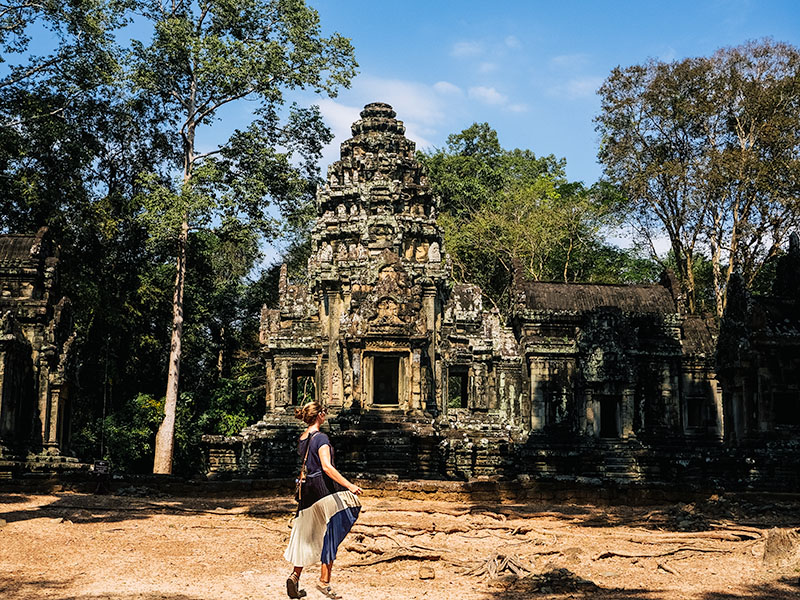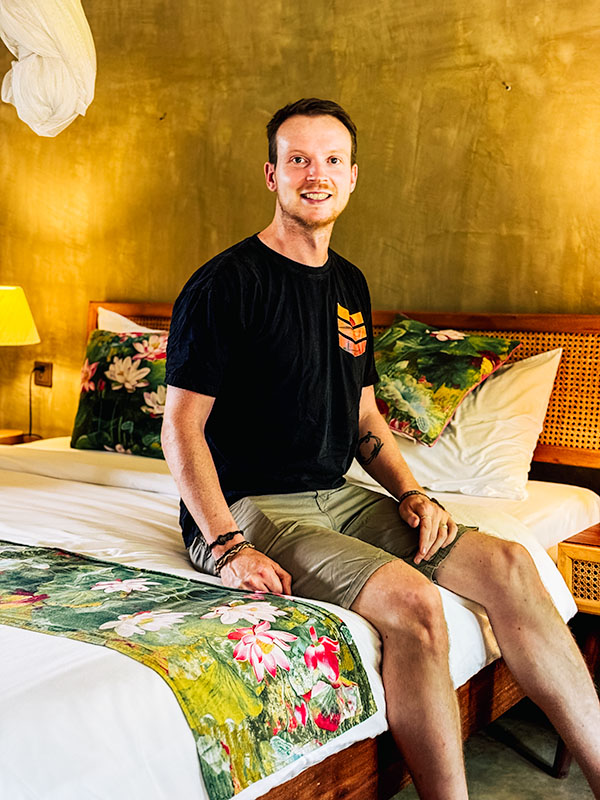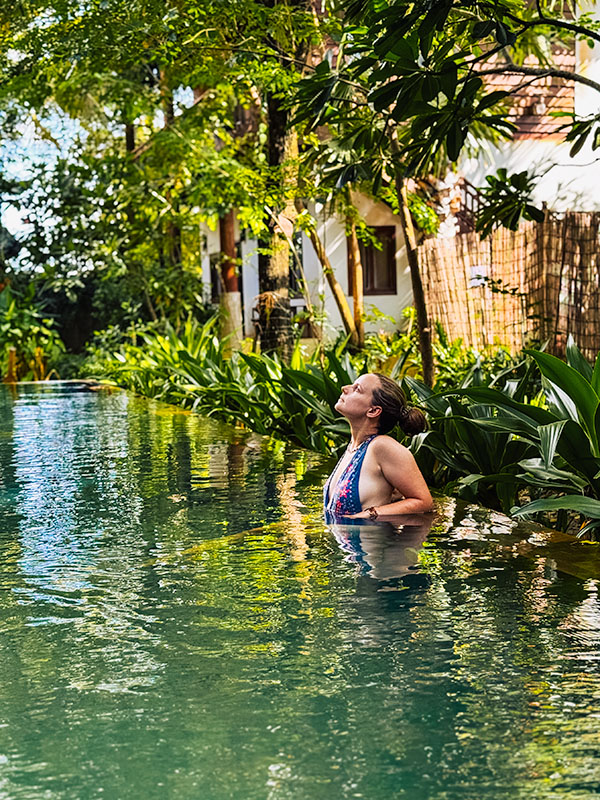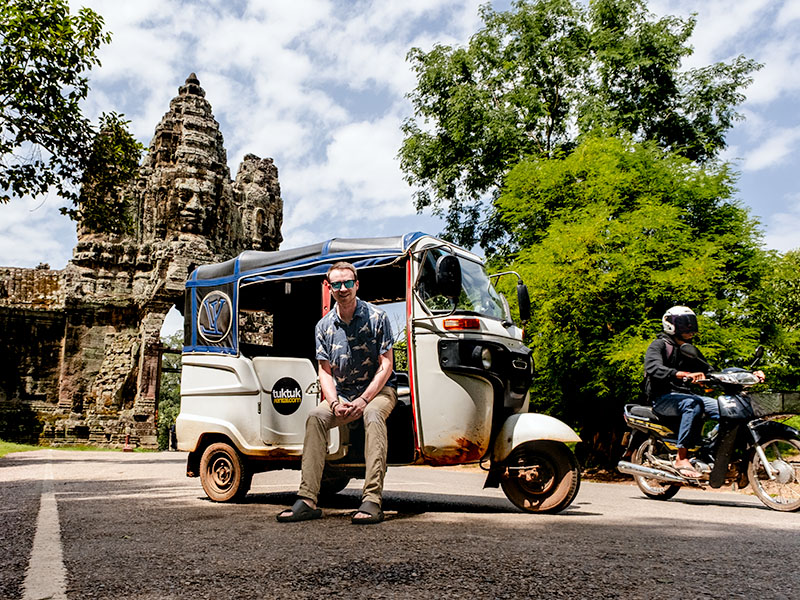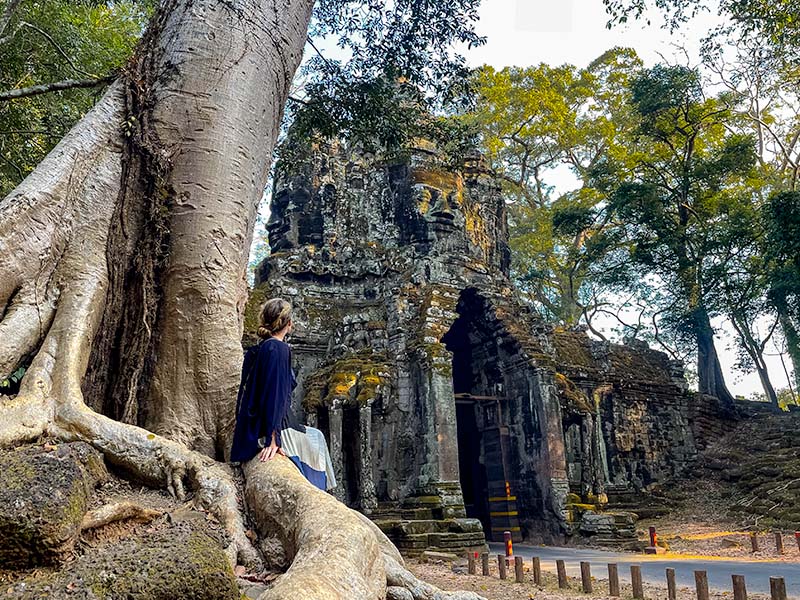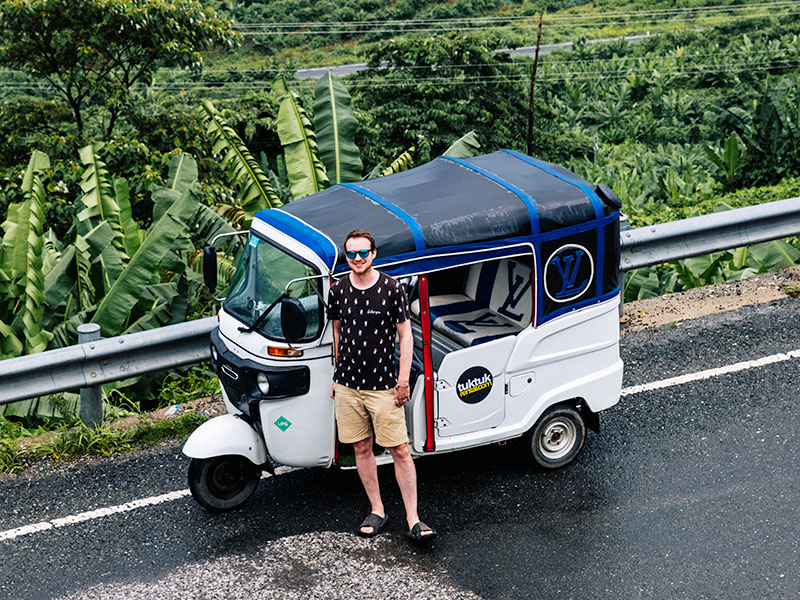Cambodia has a bit of everything: temples, islands, nature. This 2 week Cambodia itinerary gives you time to explore it all, going between the contrasting landscapes and gaining a deeper understanding of the history of one of the most underrated tourist destinations in Southeast Asia. It also takes you a little further from the usual tourist spots for a totally different vibe.
Our 14 day itinerary is ideal for first-time visitors who want to see all the best the country has to offer. We’ve spent a couple of months travelling around Cambodia, visiting places that left us speechless and others that we won’t bother talking about. In this guide, we’ve aimed for a “one size fits most” itinerary that will give you the most incredible experience in The Kingdom of Wonder.
The route
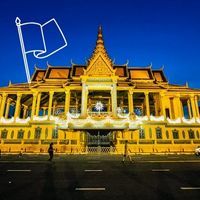
Days 1-2: Phnom Penh
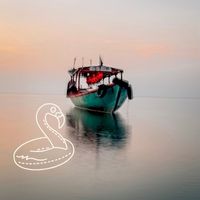
Day 3-4: Kep
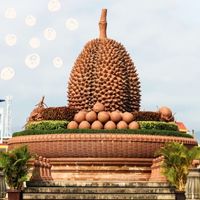
Days 5-6: Kampot

Days 7-9: Mondulkiri

Day 10: Kratie
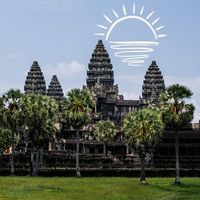
Days 11-14: Siem Reap
How to spend 14 days in Cambodia
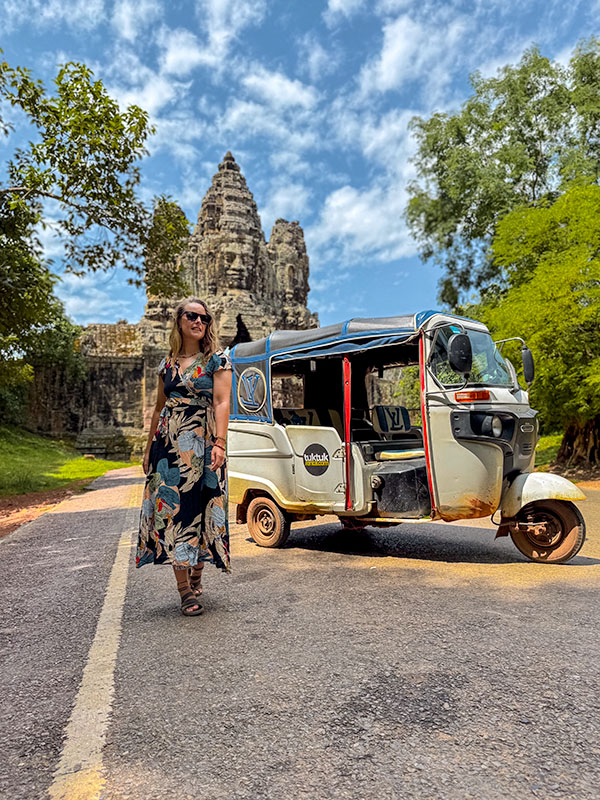
Days 1 & 2: Phnom Penh (Palace and history)
Phnom Penh is most people’s entry point to their 2 week Cambodia visit. I’ll be honest, it’s not our favourite place, but it has some important sites so we don’t think you should skip it.
Compared to its neighbours, such as Bangkok and HCMH, however, it’s relatively calm and shouldn’t be too overwhelming for you straight off the plane. From the airport, it’s around 30 minutes by taxi (use Grab – it’s the Uber of SE Asia) to the area around the Royal Palace and Riverside which are the best areas of the city to stay in on your first visit.
First day
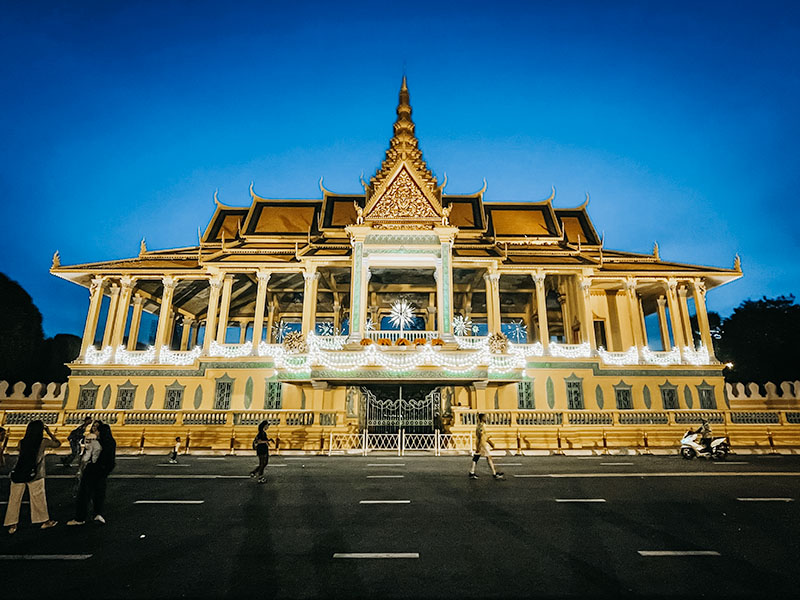
We’d recommend having a walk around some of the capital’s beautiful cultural sites.
The Royal Palace is a stunning complex of buildings and is well worth the $10 entry fee. However, there’s some things you need to keep in mind before you visit:
- Tuktuk drivers sometimes say the Palace is closed and suggest a guided tour of the city instead. Occasionally it’s true (especially around lunchtime), but more often it’s just a sales pitch. Always check for yourself.
- There’s a strict dress code for both men and women – you must have your shoulders, back, and knees covered to enter. This is also true of many temples around the country so be aware when you’re visiting religious sites and pack a cover up if you need to.
- There is little to no information inside the Royal Palace. If you want to know more then you’ll need to pay for a guide from inside the palace.
After you’ve finished wandering The Royal Palace you can walk (or get a tuktuk on Grab) up to Wat Ounalom. It’s a gorgeous monastery with highly decorated stupas. If you’re feeling extra energetic we really liked the small Wat Phnom Daun Penh, which is the tallest religious structure in the city.
In the evening, check out one of the night markets like Phnom Penh Night Market to try some street food.
Khmer cuisine, generally, isn’t as spicy as the food from the neighbouring Vietnam, Laos, and Thailand. Vendors usually assume Western tourists don’t want spicy food. If you do, you’ll have to ask for it.
There are loads of great local dishes to try – look for lok lak (sauteed beef salad), kuy teav (noodle soup), amok (curry steamed in banana leaves), green mango salad (this one will be spicy), or num pang (Cambodian banh mi).
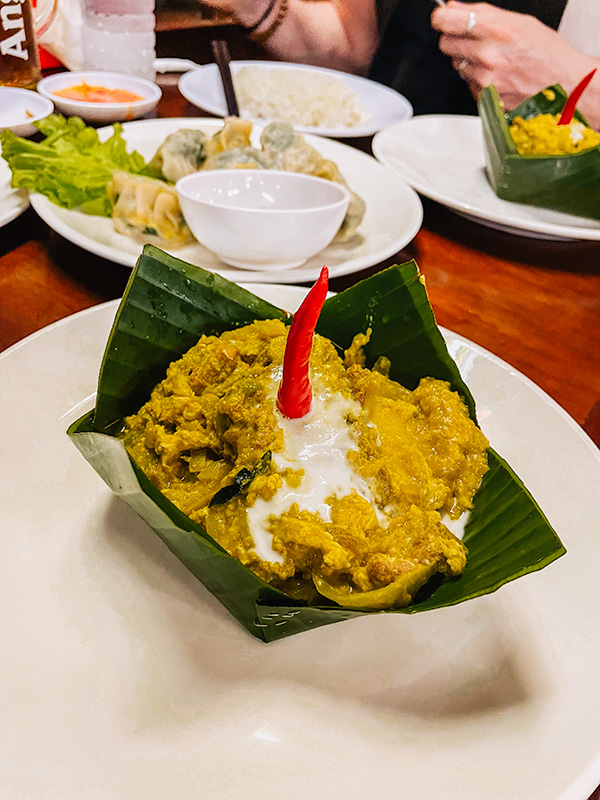

Left: chicken amok. Right: Beef lok lak
If you’re too jetlagged
Phnom Penh also has many affordable hotels with beautiful pools to relax by. So if you need to decompress from your flight or adjust to the timezone and heat, that’s also an excellent use of your first day.
Second day
The main reason to visit Phnom Penh is to learn about the darkest period of Cambodian history – the time under the Khmer Rouge and the civil war that followed.
This is obviously harrowing and upsetting to learn about so we recommend not overpacking your itinerary for this day so you can process your emotions. It’s critical to understanding modern Cambodia, and a very important period in the history of the region.
We visited the Choeung Ek Genocidal Center (Killing Fields) and Tuol Sleng Genocide Museum (S21 Prison Museum) as part of an organised tour with a guide. It costs around $20 for a half-day group tour.
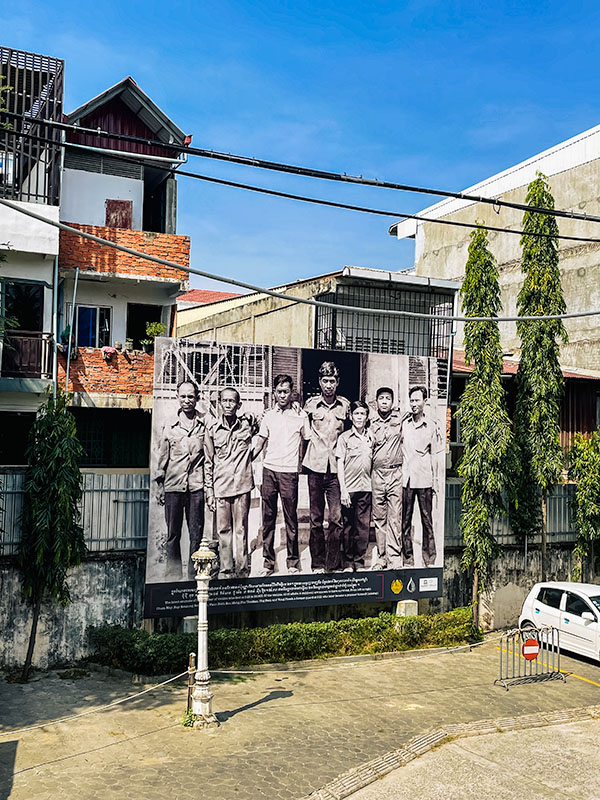
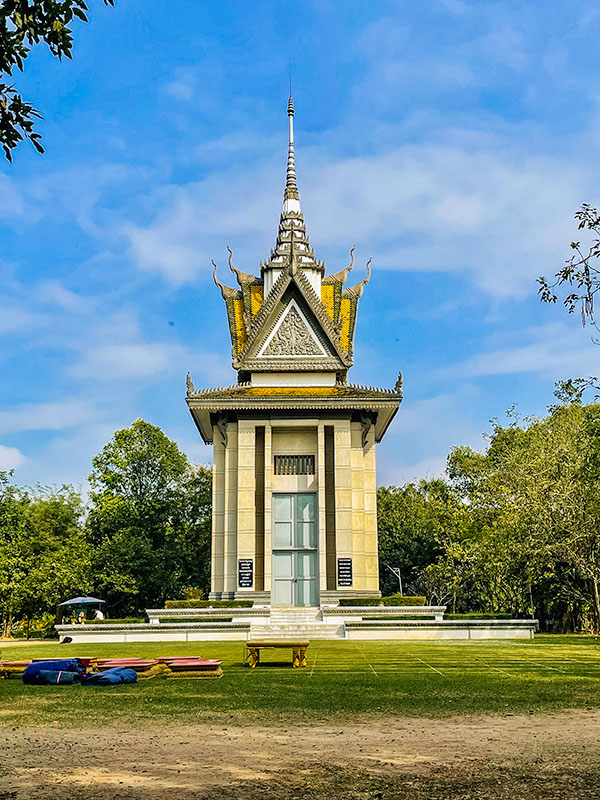
This is one occasion where we’d recommend not skipping getting a guide, even if you’re tight on budget. There’s not a huge amount of information you can read, especially at the Killing Fields. Plus hearing the personal perspective of your Cambodian guide is far more meaningful and impactful, allowing you to better understand how the country is healing.
After, you might just want to lie down, process, and maybe read some fairy smut by the pool. Or head to a lovely riverside café like Tube Coffee for the afternoon.
But, if you’re feeling up to it, a cooking class is also an excellent way to finish your day. Food heals all wounds after all.
We went to a class with Banana Cooking School, and it was superb. Classes start at 3pm and include a market tour and cooking up a full spread (go hungry!) – you can book the class directly on their website. Not only do you learn some recipes that you can take home with you, but you get a better understanding of Khmer cuisine and its roots/flavours.
Our favourite hotels in Phnom Penh
Pooltop Phnom Penh
Walking distance to centre. All the basics + a lovely rooftop pool
Budget-friendly
Amanjaya Pancam Suites
Stunning rooms with a terrace overlooking the river, and a rooftop bar
Bougie
The Palace Gate Hotel & Resort
Facilities of a 5* hotel at mid-budget prices
Luxury for less
Days 3 & 4: Kep/Koh Tonsay (a slower pace of life)
After the intensity of Phnom Penh, we recommend heading to the coast for a couple of slower days by the sea.
Kep is a quiet town known for its seafood, sunsets, and laidback atmosphere. You have 2 equally great options depending on how off-grid you want to go:
Option 1: Stay on Koh Tonsay (Rabbit Island)
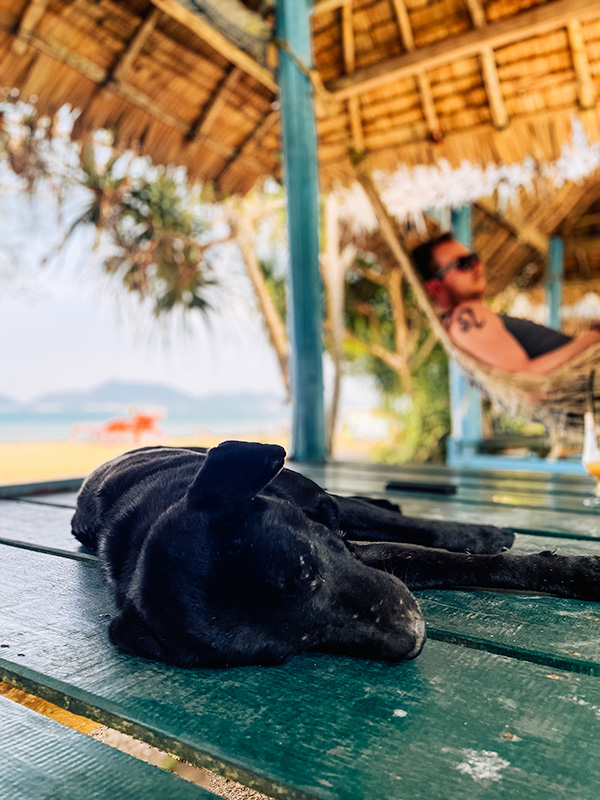
Koh Tonsay is a small island around 20 minutes by long-tailed boat from Kep pier. There’s one sandy “street” lined with simple beach huts, no WiFi, and limited electricity. We stayed for two nights and spent most of the time in hammocks reading, swimming, and eating fresh seafood.
I could literally feel my battery recharging whilst swinging back and forth in the hammock with absolute zero cares in the world.
We stayed at Khim Vouch Ay – the only guesthouse currently on Booking.com.
They have bamboo huts with basic bathrooms, electricity in the evening for a fan and phone charging, and a restaurant that does amazing food. So it’s not the luxury beach experience, it’s more for shutting off from the world. The staff are incredibly kind and helpful, and you can book boat transfers directly with them or through your accommodation in Kep.
The water’s great for swimming, and if you bring a snorkel, you can paddle around near the rocks. It’s very basic, but fantastic if you want to switch off, literally.
Option 2: Stay in Kep Town
If no WiFi and no hot water doesn’t sound like your idea of fun, you can base yourself in Kep and take a day trip to Rabbit Island instead. Boats leave from Kep pier daily and cost around $10 return.
Kep has great value hotels right by the beach, like Saravoan-Kep and The Beach House which both have sea views. You’re also only 5 minutes from the Crab Market, where you’ll find grilled crab served with Kampot pepper – one of the most famous, and delicious, dishes in Cambodia.
Days 5 & 6: Kampot (pepper farms & river life)
Kampot pepper is one of Cambodia’s most well-known exports, often found on fine dining menus around the world. The town itself doesn’t have a lot to offer. But the surrounding area is well worth visiting for the river, jungle, and feeling of being away from the world.
We recommend spending a couple of nights here to explore a pepper farm and experience more of Cambodia’s incredible scenery. Most pepper farm tours are free though you’re generally expected to buy something from them. So your main cost will be getting there – we massively recommend renting a tuktuk for your full trip to explore on your own steam. But you can also get a scooter for the day or ask your hotel to arrange a tuktuk driver for the day for you.
La Plantation is the most well-known pepper farm in the area, with a free guided tour and restaurant on site. It’s about 45 minutes from Kampot by scooter or tuktuk and sits in a beautiful rural area that’s nice to explore. You could also add on a stop at the Secret Lake or Phnom Chhnork Cave if you’re already out that way.
For the full condiment set, you can also visit the salt fields of Kampot. BUT they don’t produce salt year-round, only from late December to April. We were there at the wrong time of year, so have only seen stunning pictures – especially around sunset.
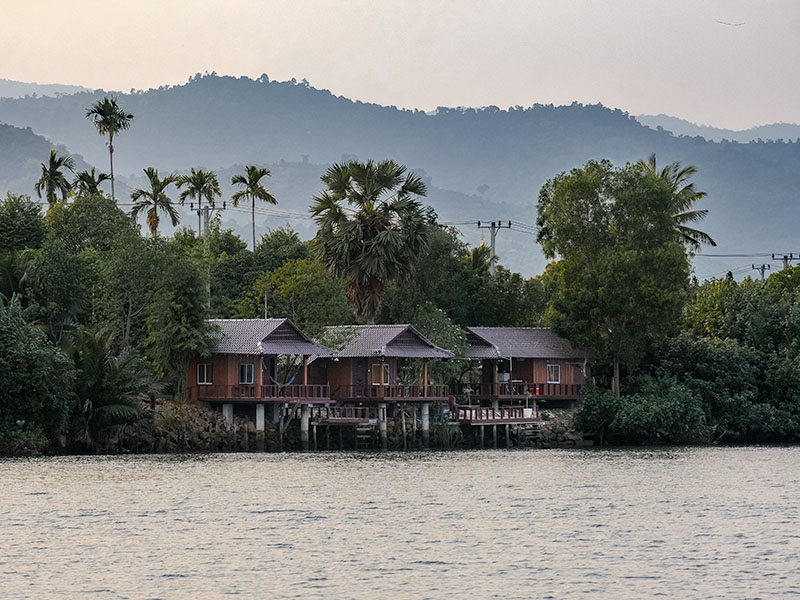
We stayed at Eden Eco Village, which is a few kilometres outside of town, right on the Kampot River. The riverside huts are basic but comfortable and come with free kayaks so you can paddle straight from your room. After about 10 minutes of slow paddling you’ll feel like you’re exploring an undiscovered land. It’s run by a group of social enterprises providing jobs and training for local women, and the restaurant on site served probably the best food we’ve ever eaten in Cambodia. The team can help organise transport or any tours you want to do in the area.
Our favourite hotels in Kampot
Eden Eco Village
Rustin huts right on the Kampot River with free kayaks
Budget-friendly
La Plantation Villa
For something a little more bougie, stay at a pepper and spice plantation
Bougie
Days 7-9: Mondulkiri (elephant sanctuary and deep jungle)
As you approach Sen Monorum, the landscape changes drastically. There’s much more hills and jungle, as well as a drop in temperatures. The road has recently been upgraded so, thankfully, the journey isn’t too bumpy.
This is one of the few places left in Southeast Asia where you can trek deep into protected forest and see elephants. Which is why we’ve included it on this 2 week Cambodia itinerary even with the long journey to get there.
There are a lot of elephant “sanctuaries” in Mondulkiri that are not ethical, and jungle trekking companies that also offer elephant riding. Riding elephants is NEVER ethical.
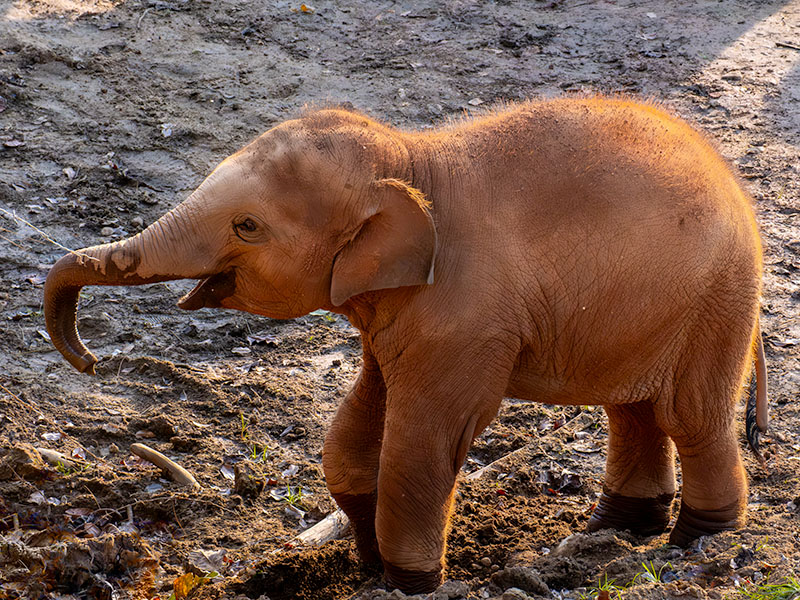
We recommend Elephant Valley Project as they’re the only place we know to be truly ethical. They’re a registered NGO leading the way in animal welfare in Cambodia. So they only offer the chance to watch elephants being real elephants in completely hands-off way to allow the rescued elephants to return to their natural behaviours and habitats in the forest.
You can visit them for the day, walking alongside these gentle giants in the forest. Or you can do an overnight stay for a life-changing experience in the jungle and a chance to spot other wildlife. Book directly with them to make sure all your money goes directly towards the project and not third parties.
If you’re not staying in the jungle, we loved our stay at PIDA Coffee Farm. It’s a tiny bit outside the town and has comfortable rooms, great food, and a truly stunning view from their pool.
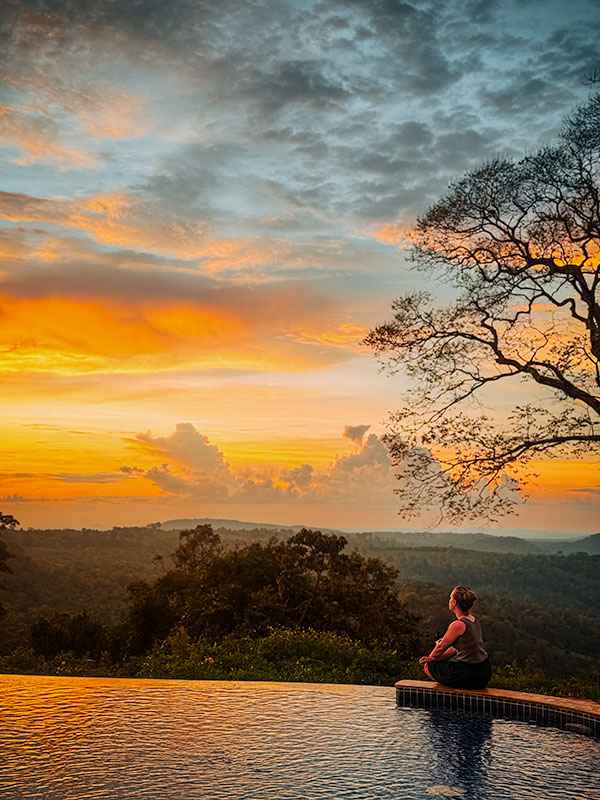
The coffee is also excellent as they grow it themselves. It’s great value to stay there, and they’ll happily help you with any tours you want to do or transport in the area and beyond.
Day 10: Kratie (kayaking with river dolphins)
There are very few places on Earth where you can see wild river dolphins – and Kratie (a small town on the Mekong) is one of those places.
As it’s just a few hours from Mondulkiri, you can travel in the morning and see the amazing dolphins in the afternoon. The bus should cost around $10.
We did a half-day kayak trip to see the river dolphins with Lucky, a former fisherman who now guides people to where the dolphins hang out. The trip involves a tuktuk ride out of town and then a 10km kayak – thankfully it’s downstream so it isn’t too hard – with a stop for snacks and swimming.
This takes you to Kampi, the area where the Irrawaddy dolphins live. From your kayak, you can *hopefully* see them briefly surface for air, chase fish, or even jump and play (though this is super rare). Obviously, as they’re wild animals, there’s never a guarantee that you’ll see them. We were incredibly lucky and saw maybe 20 of them and one even swam really close to our kayak.
They’re also ludicrously difficult to photograph as you have no idea where they surface for such a short amount of time.
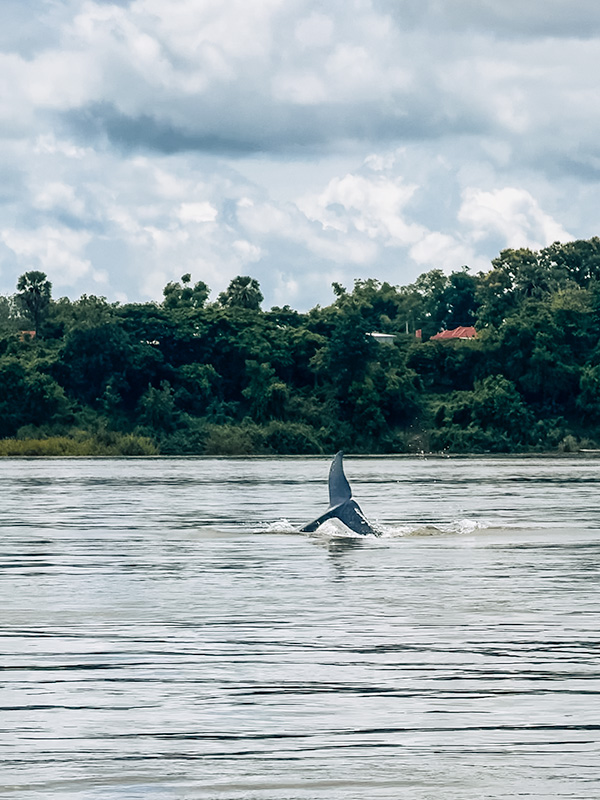
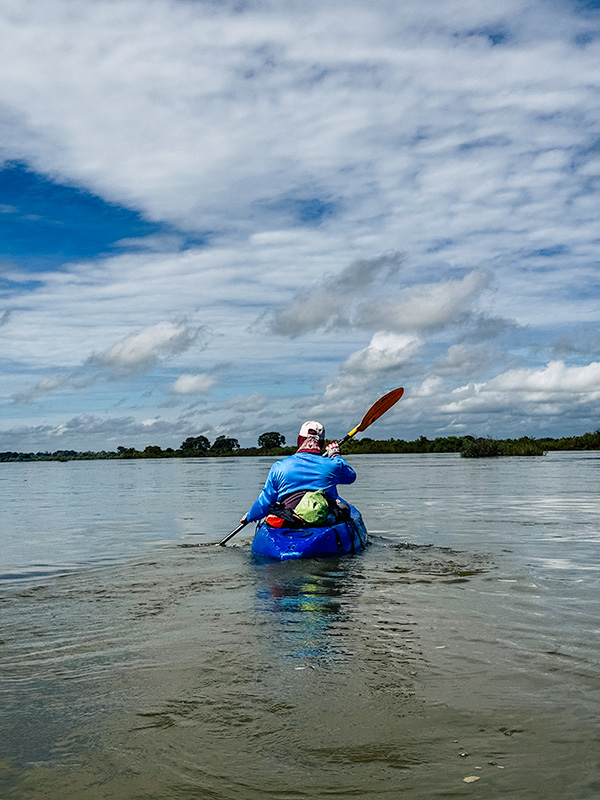
The cost depends on how many people are on your tour (he only does small tours) but expect around $30-40 per person for the half day tour. You can book via his website to guarantee availability.
You can also see the dolphins from a motorboat tour. However, the loud motors disturb the dolphins so we’d really recommend using a kayak if you’re able. We’re rubbish kayakers and managed fine (though our shoulders were feeling it in the morning!)
Make sure to grab some food at Street Three Eatery. It’s a fantastic restaurant and social enterprise with lots of local, international, and vegan options. They open at 8am for breakfast and 4.30pm for dinner (closed Sundays). So you should be able to enjoy at least one meal here.
Days 11-14: Siem Reap (ancient temples and more)
The main reason most people visit Cambodia is to visit the jewel of Siem Reap: Angkor Wat. But that’s not all that’s in the city if you need a break from all the temples so we’ve broken it down to give you different options.
Our favourite hotels in Siem Reap
Blossoming Romduol Boutique
Simple rooms & pool within walking distance of the centre
Budget-friendly
The Twizt
A bougie hostel/hotel with swanky communal areas & rooftop pool
Bougie on a budget
Dontrei Villa Angkor
Stunning rooms in traditional Khmer buildings with lush gardens and 2 pools
Luxury for less
Angkor Wat and the Angkor Archaeological Park
Angkor Wat is just one temple in the enormous Angkor Archaeological Park – it was once the biggest city in the world. Inside the park, you’ll find many beautiful temples in various states of restoration or being reclaimed by the forest.
A ticket is essential to visit and you need to buy them online in advance. The ticket is a QR code so it’s best to screenshot it, as signal is pretty patchy around the park and it might not load off of data.
You can get a 1, 3, or 7 day ticket. Unless you literally only want to see Angkor Wat, we’d recommend the 3-day ticket. It means you can explore the ancient ruins more leisurely since there’s very little shade inside so a full day from sunrise to sunset would be very intense.
Sunrise at Angkor Wat
One morning, get up early to see the sunrise over at Angkor Wat.
It’s a bucket list activity for a lot of people so, yes, it gets very busy. And it can sometimes be underwhelming if the weather doesn’t play ball. But honestly, how often are you going to be at Angkor Wat? Losing a few hours of sleep is worth the chance of seeing something really special.

Getting around
The temple complex is a few kilometres from the centre of Siem Reap and, once there, the temples themselves are very spread out. You can choose to get around by:
- Bicycle
- Scooter or electric bike
- Your own tuktuk (our favourite – you can read about how we rented a tuktuk, here)
- Tuktuk with driver
- Car and driver
We’ve done both self-driving our own tuktuk (get an automatic discount on your booking, here) and hiring a tuktuk with a driver, which is also excellent. Due to the heat and distance, we wouldn’t recommend bicycles unless you truly enjoy sweating.
Stay cool and take it slow
It gets incredibly hot around the temples and there’s less shade than you might expect, even with all the trees. Make sure to stay hydrated, take breaks, and don’t try to rush.
Non-Angkor Wat activities
- Phnom Kulen National Park: Jungle hikes, ancient temples, and a beautiful waterfall. It’s not a “hidden gem” exactly, but it’s further off the typical tourist trail and makes for a great day out.
- Visit a floating village on Tonlé Sap lake: There are a lot of tours available, but we recommend only booking through Kompong Khleang Floating Village Tours, a local community tourism group, to ensure the money goes directly to the people who live there. They use local guides and reinvest your tour fee into education and development in the village.
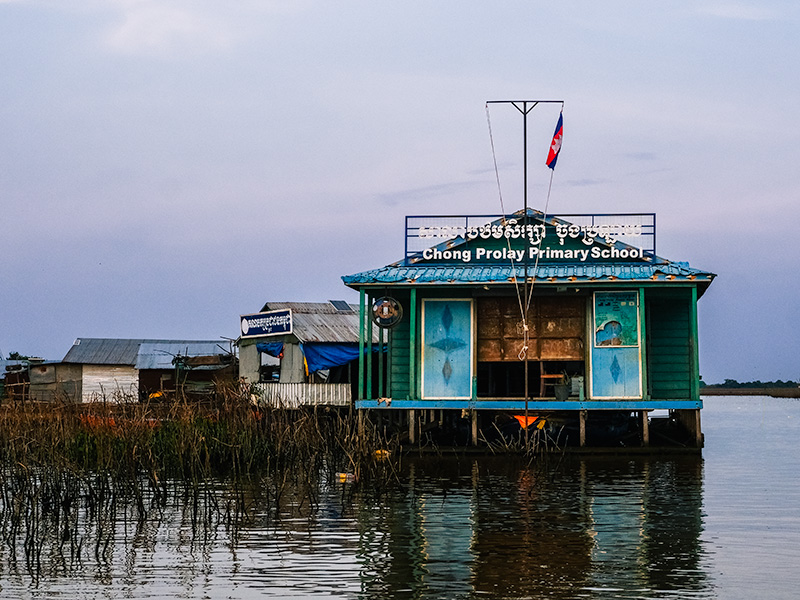
- Enjoy fantastic cocktails: You can head to Pub Street if you want to down cocktail buckets and hang out with young people who use slang I don’t understand. Alternatively, there are plenty of excellent bars around the city if you’re after a more civilised experience. Three of our favourites are:
- Bar43 – creative cocktail list using local ingredients
- Wild – their drinks are good but their spring rolls are exceptional
- Miss Wong Cocktail Bar – classic drinks in a 1920s Shanghai-inspired bar

- Watch a performance by Phare, the Cambodian Circus: We missed it the first time we visited Siem Reap and made sure not to the second time around. Phare is a one-hour acrobatic show performed by young Cambodian artists trained at their school in Battambang. No animals, just great stories, acrobatics, and theatre. It runs nightly at 8pm (doors at 7:30pm) and costs around $30. Worth every cent. There are traditional dances performed at 7pm by young students if you want to see those too.
- APOPO Visitor Centre: Learn about the incredible work of the Hero Rats helping to clear the country of landmines.
Sunset Spots Near Siem Reap
- Phnom Bakeng: The most popular sunset viewpoint inside the Angkor complex. From the top of the temple, you get panoramic views across the forest and a distant glimpse of Angkor Wat. Only 300 people are allowed up each day, so arrive early. If you’ve seen those dramatic photos of Angkor Wat at sunset? They were likely taken with a big zoom lens – it doesn’t look that close in real life.
- Phrom Krom: Located south of the city, this small temple sits on a hilltop and has a much quieter 360° sunset view. On the way, you’ll likely pass locals picnicking on the roadside. In the wet season, the flooded fields reflect the sunset beautifully but when we went, a massive storm cloud blocked the view. Whether the weather’s on your side or not, it’s still a peaceful, scenic place to end your day. In theory you need the Angkor Pass to visit, but nobody seemed bothered about checking.
Best time to visit
The best time of year to visit Cambodia is December to February. This is the coolest part of the dry season though it’s never really “cool”. At this time of year you’re most likely to get bright sunny days without the heat and humidity overwhelming you.
March and April are dry but extremely hot and humid. It’s best to avoid this time unless you’re used to extreme heat or you’re happy to hide from the sun for the hottest parts of the day.
Wet season runs from May to October. The heavy rain does help to cool the temperatures but makes many activities more difficult, or impossible in the case of river and jungle ones. You can get some fantastic deals on hotels but be aware that you’ll need to keep your plans flexible.
Budget for your Cambodia trip
Cambodia is very affordable to explore. Some people are shocked that it is more expensive than its neighbors, Vietnam and Laos, but you can easily explore Cambodia on a tight budget as long as you’re careful.
Your budget will be totally personal depending on your hotel choices, if you’re more into street food or restaurants, or how many little treats you have.
But as a rough guide (per person, per day)
- Budget traveller $40-50
- Mid-Budget traveller $70-90
- Luxury traveller $120+
How to get around Cambodia
There’s options to suit everyone, depending on your preference for comfort, speed, and a little sense of adventure.
Public Transport
The best combination of budget and ease is to use the shared minivans and buses that connect all the major cities and towns in Cambodia. Most of these can be booked online or through your accommodation. We tend to use 12Go Asia when booking public transport.
There are basically no trains to speak of, but you can fly domestically. We’d only recommend this to get to the islands from either Phnom Penh or Siem Reap.
Private Transfer
It’s possible to get private transfers between each place but expect these to be 6-8x the price of the shared minivans and buses.
Tuktuk
Our favourite way to explore Cambodia is by driving your own tuktuk. This itinerary is too fast paced for that to really work, but if you wanted to go to fewer places and explore more deeply or off the beaten path, then it’s a brilliant way to do that. As Tuktuk Rental’s office is in Siem Reap, it’s also a great option for exploring Angkor Wat.
Scooter
For getting between each stop of this itinerary, a scooter’s not a great option. But when you’re exploring the cities and surround areas, it’s an affordable way to get around. They’re available nearly everywhere and you should expect to pay $10-15 per day. Just make sure the scooter is in good condition, the rental shop has good reviews, and you always wear a helmet.
Read next: Tuktuk vs Scooter – Which is best for your Cambodia trip?
Final Thoughts
We wish we could include every amazing thing there is to do in Cambodia in 2 weeks, but realistically, you need over a month to do that. This 2 week Cambodia itinerary is focused on giving you the truly unique experiences of this amazing country and introducing you to the history, food, and culture that make it so special.
If it feels a little too much movement then you can choose one of Kep and Kampot and skip the other, or add more days elsewhere instead of heading into the jungle in Mondulkiri. You could always take our 1 week itinerary and spread it over 2 weeks for a more chilled experience. You do you, but this is what we would do.
Cambodia
Browse all our guides here

